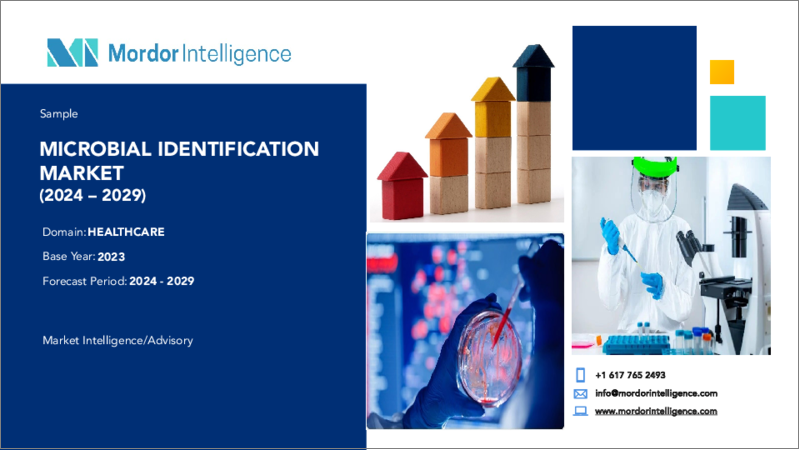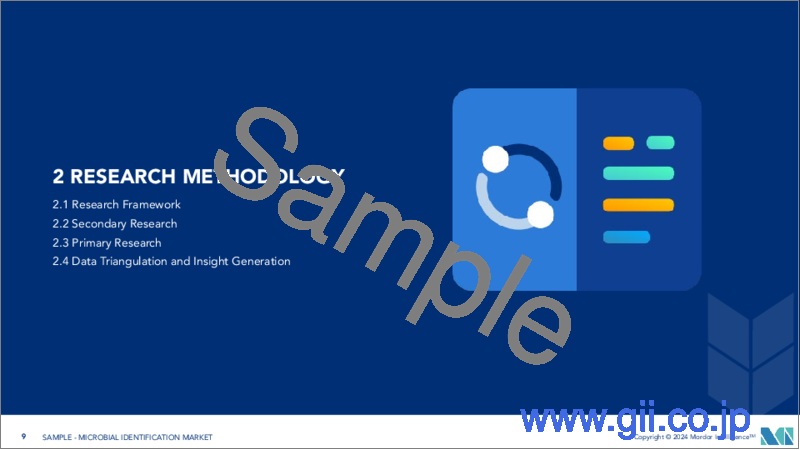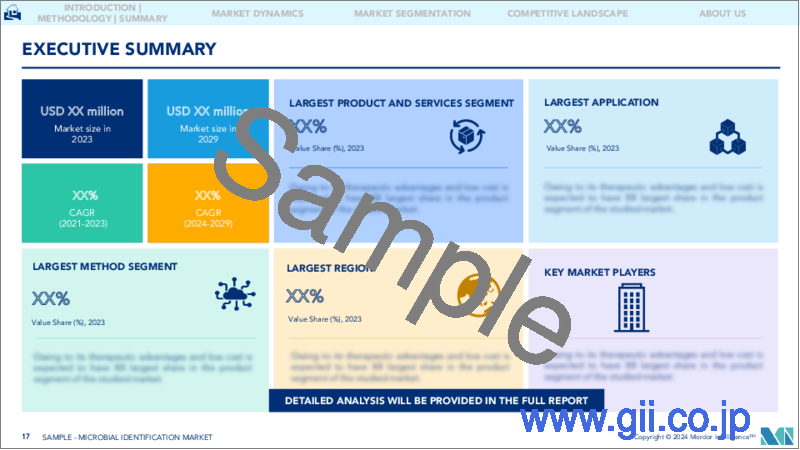|
|
市場調査レポート
商品コード
1145975
微生物同定市場- 成長、動向、予測(2022年~2027年)Microbial Identification Market - Growth, Trends, and Forecasts (2022 - 2027) |
||||||
|
● お客様のご希望に応じて、既存データの加工や未掲載情報(例:国別セグメント)の追加などの対応が可能です。 詳細はお問い合わせください。 |
|||||||
| 微生物同定市場- 成長、動向、予測(2022年~2027年) |
|
出版日: 2022年10月31日
発行: Mordor Intelligence
ページ情報: 英文 114 Pages
納期: 2~3営業日
|
- 全表示
- 概要
- 目次
微生物同定市場は、予測期間中に7.0%のCAGRで推移すると予測されています。
COVID-19の発生は、市場に大きな影響を及ぼしています。雇用の閉鎖によって輸出入活動が抑制され、診断センターや病院が閉鎖されたためです。例えば、2021年9月に発表された「Impact of the COVID-19 pandemic on the surveillance, prevention, and control of antimicrobial resistance:a global survey」という論文によると、抗菌薬耐性に関する看護、医療、公衆衛生スタッフの稼働率がそれぞれ71%、69%、64%減少していることが明らかになっています。しかし、COVID-19制限の解除と産業界における診断および検査サービスの再開により、調査対象市場は予測期間中に成長すると予想されます。
市場の成長を推進する特定の要因は、感染症の負担の増加、微生物同定の技術的進歩、食品安全への懸念の増加、微生物同定を促進するための政府の取り組みや資金調達です。
感染症の蔓延が増加していることは、市場成長を促進する重要な要因となっています。例えば、世界保健機関が発表した「Global Tuberculosis Report 2021」のデータによると、結核患者の多くは、東南アジア(43%)、アフリカ(25%)、西太平洋(18%)の世界保健機関(WHO)地域で見られ、東地中海(8.3%)、アメリカ(3.0%)、欧州(2.3%)では結核患者の数は少なくなっているとのことです。同様に、2021年に発表された世界保健機関(WHO)のデータによると、サハラ以南のアフリカはマラリアの負担に耐え続け、全患者の約95%、全死亡者の96%を占めているようです。このように、感染症の症例が増加することで、微生物同定の需要が高まり、市場の高成長が期待されます。
さらに、包装された食品と包装されていない食品における食品安全への懸念の高まりも、市場の成長に寄与しています。最近の人々は、微生物汚染のリスクが高い加工食品を消費する方向にシフトしています。例えば、2020年12月にNutrition and Diabetesが発表した「オーストラリアの成人人口における超加工食品消費と肥満」という論文によると、オーストラリアの成人の80%が日常生活で大量生産されたパッケージパンや惣菜、ファーストフード料理や菓子パン、饅頭、ケーキなどの加工食品やジャンクフードを消費していることが判明しているとのことです。したがって、このような加工食品の消費量が多いことから、安全で高品質な食品を国民に届けるための微生物同定に対する需要が高まると予想されます。
さらに、2022年5月に世界保健機関が発表したデータによると、毎年推定6億人が汚染された食品を食べて病気になり、420,000人が死亡しています。また、中低所得国では、安全でない食品に起因する生産性や医療費で毎年1100億米ドルが失われています。したがって、食品汚染の発生率の上昇により、病気を引き起こす特定の微生物を検出するための食品検査の必要性が高まっています。
さらに、2020年、世界保健総会は、世界保健機関に対し、2025年までに食品由来疾患の世界の負担について、発生率、死亡率、疾病負担の最新の推定値を報告するよう求める新たな決議を採択しました。この決議は、WHOが国、地域、国際レベルで食中毒や人獣共通感染症の世界の負担を監視することを義務付けています。政府によるこうした取り組みも、市場の成長に寄与しています。
しかし、自動微生物同定システムのコストが高いことが、予測期間中の市場成長の妨げとなる可能性があります。
主な市場動向
インストルメントが製品・サービスセグメントの成長を牽引
機器セグメントは、感染症負担の増加、微生物同定に関する意識の高まり、技術的に進んだ製品の出現などの要因により、予測期間中、調査対象市場で大きな成長を遂げると予想されます。
識別可能な生物の範囲は年々拡大し、より幅広い微生物株が含まれるようになっています。その中には、臨床検体から質量分析計(MS)を用いて迅速に分離菌を同定する技術も含まれています。
感染症の流行に伴い、その原因となっている微生物を特定する必要性が高まっています。例えば、2022年7月に発表された世界保健機関のデータによると、ガーナのアシャンティ地方からマールブルグウイルス病(MVD)の死亡例が2件報告され、その後マールブルグウイルスに陽性反応が出たとされています。さらに、2022年4月に発表されたニュースでは、フロリダ州で、セログループC型髄膜炎菌感染症の重大な発生があり、ほとんどがHIV陽性の人を含む他の男性と性交する男性に影響を及ぼしているとされています。
さらに、微生物同定製品の開発における企業活動の高まりも、予測期間中のセグメント成長を後押しすると予想されます。例えば、2021年7月、Bruker Corporationは、MALDI Biotyper(MBT)プラットフォームの新製品およびメソッド、MALDI Biotyper Siriusを発売し、培養プレートおよび陽性血液培養からの「プロテオミックフィンガープリント」による迅速、ほぼ普遍的かつコスト効率の高い微生物同定のワークフローをサポートします。また、2021年4月、bioMerieux社は、数分でルーチンの微生物同定を行うための次世代MALDI-TOF質量分析システムVITEK MS PRIMEのCEマーキングを取得しました。
このように、前述の要因から、この市場は予測期間中に成長すると予想されます。
北米が市場で最大のシェアを占める
北米は、感染症や疫病の発生、医療費の増加、確立された医療インフラの存在といった要因から、予測期間中に微生物同定市場を独占すると予想されています。
同地域における感染症の流行は、市場の成長を促進する重要な要因となっています。例えば
2022年3月にCenters for Medicare &Medicaid Servicesが発表した「CMS Office of the Actuary Releases 2021-2030 Projections of National Health Expenditures」と題するデータにより、2021年から2030年にかけて国民医療費の年間成長率は平均5.1%と予想されていることが確認されています。また、2020年の国民医療費は4兆1,000億米ドルであり、2030年には6兆8,000億米ドルに達すると予測されています。したがって、ヘルスケア支出の増加は、技術的に高度な検査製品や機器の開発における企業活動や政府のイニシアチブを増加させ、それによって市場成長を推進すると予想されます。
また、技術的に高度な製品の台頭や、同地域における主要な市場プレイヤーの存在も、予測期間中の市場成長を後押しするものと思われます。例えば、2022年1月、BDは、微生物学細菌同定検査の準備を自動化するために設計されたBD Kiestra IdentifAシステムで米国食品医薬品局から510(k)認可を取得しました。また、2021年1月には、ブルカー株式会社が、MALDI Biotyper CAシステムで陽性血液培養から425種類以上の微生物を迅速に同定するためのMBT Sepsityper Kit US IVDを発売しています。
このように、前述の要因から、調査対象市場は予測期間中に成長すると予想されます。
競合情勢
本市場は、世界企業とローカル企業の両方が存在するため、競争は緩やかです。現在、少数の企業が市場で健全なシェアを占めています。例えば、Thermofisher Scientific、BioMerieux SA、Beckman Coulter Inc.、Shimadzu Corporation、Becton, Dickinson and Companyが、かなりのシェアを持つローカルおよび中小企業とともに、市場の主要企業となっています。
その他の特典
- エクセル形式の市場予測(ME)シート
- アナリストによる3ヶ月間のサポート
目次
第1章 イントロダクション
- 調査の前提条件と市場の定義
- 調査対象範囲
第2章 調査手法
第3章 エグゼクティブサマリー
第4章 市場の力学
- 市場概要
- 市場促進要因
- 感染症負担の増加
- 微生物同定の技術的進歩
- 食品安全への懸念の高まり
- 微生物検出を促進するための政府の取り組みと資金援助
- 市場抑制要因
- 自動微生物同定システムの高コスト
- ポーターのファイブフォース分析
- 新規参入業者の脅威
- 買い手/消費者の交渉力
- 供給企業の交渉力
- 代替品の脅威
- 競争企業間の敵対関係
第5章 市場セグメンテーション(金額ベース市場規模:百万米ドル)
- 製品・サービス別
- 機器
- 消耗品
- サービス別
- メソッド別
- フェノタイピックメソッド
- ジェノタイピングメソッド
- プロテオミクスベースメソッド
- アプリケーション別
- 診断薬
- 飲食品検査
- 医薬品
- 化粧品・パーソナルケア製品検査
- その他のアプリケーション
- 地域別
- 北米
- 米国
- カナダ
- メキシコ
- 欧州
- ドイツ
- 英国
- フランス
- イタリア
- スペイン
- その他の欧州地域
- アジア太平洋地域
- 中国
- 日本
- インド
- オーストラリア
- 韓国
- その他アジア太平洋地域
- 中東・アフリカ地域
- GCC
- 南アフリカ共和国
- その他の中東・アフリカ地域
- 南米地域
- ブラジル
- アルゼンチン
- その他の南米地域
- 北米
第6章 競合情勢
- 企業プロファイル
- Becton, Dickinson and Company
- Biolog Inc.
- BioMerieux SA
- Bruker Corporation
- Charles River Laboratories International Inc.
- Danaher Corporation(Beckman Coulter Inc.)
- Eurofins Scientific SE
- Merck Millipore(Merck KGaA)
- Shimadzu Corporation
- Thermo Fisher Scientific Inc.
- VWR Corporation
第7章 市場機会と今後の動向
The Microbial Identification Market is projected to witness a CAGR of 7.0% over the forecast period.
The COVID-19 outbreak has had a significant impact on the market. As employment closures have curtailed import and export activities and closures of diagnostics centers and hospitals. For instance, according to an article titled "Impact of the COVID-19 pandemic on the surveillance, prevention, and control of antimicrobial resistance: a global survey" published in September 2021, there was a reduction in the availability of the nursing, medical, and public health staff for antimicrobial resistance by 71%, 69%, and 64%, respectively. However, with the release COVID-19 restrictions and resumed diagnosis and testing services in industries the studied market is expected to grow over the forecast period.
Certain factors propelling the market growth are the rising burden of infectious diseases, technological advancements in microbial identification, increasing food safety concerns, and government initiatives and funding for promoting microbial identification.
The increasing prevalence of infectious diseases is the key factor driving market growth. For instance, according to the data published by the World Health Organization in the Global Tuberculosis Report 2021, most of the tuberculosis cases were found in the World Health Organization (WHO) regions of South-East Asia (43%), Africa (25%) and the Western Pacific (18%), and lesser numbers of tuberculosis cases were found in Eastern Mediterranean (8.3%), the Americas (3.0%) and Europe (2.3%). Similarly, according to the World Health Organization (WHO) data published in 2021, Sub-Saharan Africa likely continues to endure the burden of malaria, accounting for approximately 95% of all cases and 96% of all deaths. Thus, rising cases of infectious diseases are expected to increase the demand for microbial testing resulting in the high growth of the market.
Additionally, the growing food safety concerns in packed and non-packed food are also contributing to the market growth. The population nowadays is more shifting toward consuming processed foods which have a high risk of microbial contamination. For instance, according to an article published by Nutrition and Diabetes, in December 2020, titled 'Ultra-processed food consumption and obesity in the Australian adult population", it has been found that 80% of the adults in Australia consumed processed or junk food, such as mass-produced packaged bread, ready meals, fast food dishes and pastries, buns and cakes, in their daily life. Thus, the high consumption of this processed food by the population is expected to increase the demand for microbial testing to deliver safe and quality food to the population.
Furthermore, as per the data published by the World Health Organization in May 2022, an estimated 600 million people fall ill eating contaminated food and 420 000 die every year. In addition, USD 110 billion is lost each year in productivity and medical expenses resulting from unsafe food in low- and middle-income countries.Thus, the rising incidences of food contamination has increased the need for food testing for detecting specific microbes causing diseases.
Moreover, in 2020, the World Health Assembly passed a new resolution requiring the World Health Organization to report on the global burden of foodborne diseases by 2025 with the most recent estimates of incidence, mortality, and disease burden. The resolution mandates WHO to monitor the global burden of foodborne and zoonotic diseases at national, regional, and international levels. Such initiatives by the government are also contributing to market growth.
However, the high cost of automated microbial identification systems is likely to impede the market growth over the forecast period.
Key Market Trends
Instruments are Driving the Product and Service Segment's Growth
The instrument segment is expected to witness significant growth in the studied market over the forecast period owing to the factors such as the rising burden of infectious diseases, growing awareness regarding microbial testing, and emerging technologically advanced products.
The range of the distinguishable organism has expanded over the years to include a wider range of microorganism strains. These include techniques for rapid isolated-organism identification using mass spectrometry (MS) in clinical specimens.
With the increasing prevalence of infectious diseases, there is an increasing need to identify the microorganism causing them. For instance, as per the World Health Organization data published in July 2022, two fatal cases of Marburg virus disease (MVD) were reported from the Ashanti region, Ghana, and were later tested positive for Marburg virus. Additionally, as per a news published in April 2022, in Florida, there has been a significant serogroup C meningococcal disease outbreak, mostly affecting men who have intercourse with other men, including those who are HIV-positive.
Additionally, the rising company activities in developing microbial testing products are also expected to boost segment growth over the forecast period. For instance, in July 2021, Bruker Corporation launched new products and methods for the MALDI Biotyper (MBT) platform, MALDI Biotyper Sirius, that supports workflows for the rapid, nearly universal and cost-effective microbial identification by 'proteomic fingerprinting' from culture plates and from positive blood cultures. Also, in April 2021, bioMerieux received CE-marking of VITEK MS PRIME, the next generation of the VITEK MS MALDI-TOF mass spectrometry system for routine microbial identification in minutes.
Thus, owing to the aforementioned factors, the studied market is expected to grow over the forecast period.
North America Accounts for the Largest Share in the Market
North America is expected to dominate the microbial identification market over the forecast period owing to the factors such as the rising burden of infectious diseases and outbreaks of epidemics, growing healthcare expenditure, and the presence of well-established healthcare infrastructure.
The increasing prevalence of infectious diseases in the region is the key factor fuelling the market growth. For instance,
As per the data published by the Centers for Medicare & Medicaid Services, in March 2022, titled "CMS Office of the Actuary Releases 2021-2030 Projections of National Health Expenditures", it has been observed that the annual growth in national health spending is expected to be average 5.1% over 2021-2030. Also, the National Health Spending in 2020 was USD 4.1 trillion and it is projected to reach USD 6.8 trillion by 2030. Thus, the increasing healthcare spending is expected to increase company activities and government initiatives in developing technologically advanced testing products and equipment, thereby propelling the market growth.
In addition, rising technologically advanced products and the presence of key market players in the region are also expected to boost market growth over the forecast period. For instance, in January 2022, BD received 510(k) clearance from the United States Food and Drug Administration for BD Kiestra IdentifA system which is designed to automate the preparation of microbiology bacterial identification testing. Also, in January 2021, Bruker Corporation launched MBT Sepsityper Kit US IVD for rapid microbial identification of more than 425 microorganisms from positive blood cultures on the MALDI Biotyper CA System.
Thus, owing to the aforementioned factors, the studied market is expected to grow over the forecast period.
Competitive Landscape
The market studied is moderately competitive, with the presence of both global and local players. Few companies currently hold a healthy share of the market. For instance, Thermofisher Scientific, BioMerieux SA, Beckman Coulter Inc., Shimadzu Corporation, and Becton, Dickinson and Company are the major players in the market, along with local and smaller companies that hold a substantial share.
Additional Benefits:
- The market estimate (ME) sheet in Excel format
- 3 months of analyst support
TABLE OF CONTENTS
1 INTRODUCTION
- 1.1 Study Assumptions and Market Definition
- 1.2 Scope of the Study
2 RESEARCH METHODOLOGY
3 EXECUTIVE SUMMARY
4 MARKET DYNAMICS
- 4.1 Market Overview
- 4.2 Market Drivers
- 4.2.1 Rising Burden of Infectious Diseases
- 4.2.2 Technological Advancements in Microbial Identification
- 4.2.3 Increasing Food Safety Concerns
- 4.2.4 Government Initiatives and Funding for Promoting Microbial Identification
- 4.3 Market Restraints
- 4.3.1 High Cost of Automated Microbial Identification Systems
- 4.4 Porter's Five Forces Analysis
- 4.4.1 Threat of New Entrants
- 4.4.2 Bargaining Power of Buyers/Consumers
- 4.4.3 Bargaining Power of Suppliers
- 4.4.4 Threat of Substitute Products
- 4.4.5 Intensity of Competitive Rivalry
5 MARKET SEGMENTATION (Market Size by Value - USD million)
- 5.1 By Products and Services
- 5.1.1 Instruments
- 5.1.2 Consumables
- 5.1.3 Services
- 5.2 By Method
- 5.2.1 Phenotypic Methods
- 5.2.2 Genotypic Methods
- 5.2.3 Proteomics-based Methods
- 5.3 By Application
- 5.3.1 Diagnostics
- 5.3.2 Food and Beverage Testing
- 5.3.3 Pharmaceuticals
- 5.3.4 Cosmetics and Personal Care Products Testing
- 5.3.5 Other Applications
- 5.4 Geography
- 5.4.1 North America
- 5.4.1.1 United States
- 5.4.1.2 Canada
- 5.4.1.3 Mexico
- 5.4.2 Europe
- 5.4.2.1 Germany
- 5.4.2.2 United Kingdom
- 5.4.2.3 France
- 5.4.2.4 Italy
- 5.4.2.5 Spain
- 5.4.2.6 Rest of Europe
- 5.4.3 Asia-Pacific
- 5.4.3.1 China
- 5.4.3.2 Japan
- 5.4.3.3 India
- 5.4.3.4 Australia
- 5.4.3.5 South Korea
- 5.4.3.6 Rest of Asia-Pacific
- 5.4.4 Middle-East and Africa
- 5.4.4.1 GCC
- 5.4.4.2 South Africa
- 5.4.4.3 Rest of Middle-East and Africa
- 5.4.5 South America
- 5.4.5.1 Brazil
- 5.4.5.2 Argentina
- 5.4.5.3 Rest of South America
- 5.4.1 North America
6 COMPETITIVE LANDSCAPE
- 6.1 Company Profiles
- 6.1.1 Becton, Dickinson and Company
- 6.1.2 Biolog Inc.
- 6.1.3 BioMerieux SA
- 6.1.4 Bruker Corporation
- 6.1.5 Charles River Laboratories International Inc.
- 6.1.6 Danaher Corporation (Beckman Coulter Inc.)
- 6.1.7 Eurofins Scientific SE
- 6.1.8 Merck Millipore (Merck KGaA)
- 6.1.9 Shimadzu Corporation
- 6.1.10 Thermo Fisher Scientific Inc.
- 6.1.11 VWR Corporation




